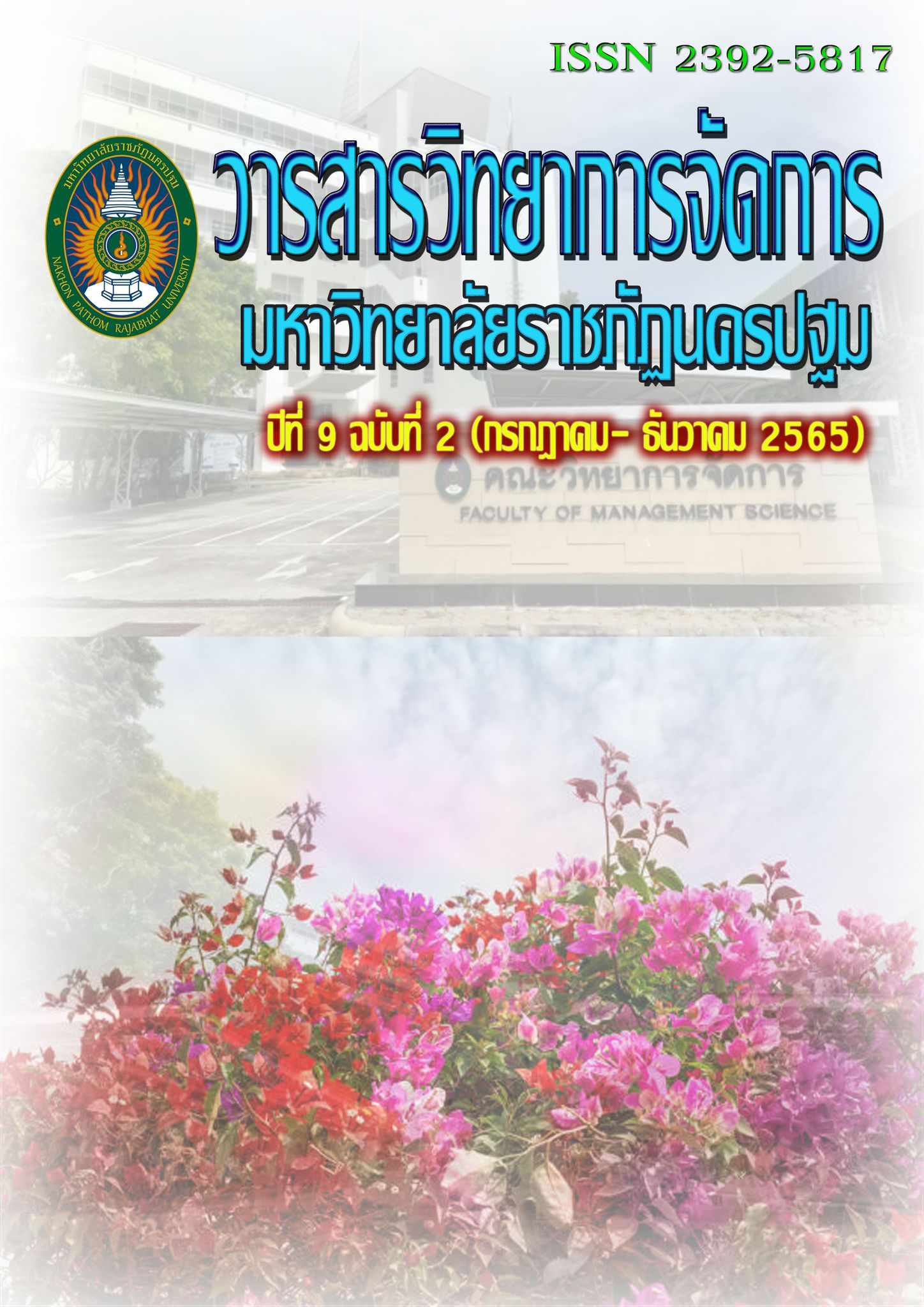A Health Literacy Guideline on Health Promotion Behaviors for Working Age Population in Bangkok and Methopolitan Region
Main Article Content
Abstract
The purpose of this research were to study factors affecting and health literacy guideline for health promotion behaviors of working age population in Bangkok and metropolitan region. The sample used in this study was 225 working people in Bangkok and metropolitan region and 5 key informants. Data were analyzed by descriptive statistics, multiple regression analysis and content analysis.
The research results revealed that 1) Health literacy factors self-management, decision skill and communication skill affecting health behavior of working age population in Bangkok and metropolitan region with significant statistics and 2) Health literacy guideline to health promotion behaviors for working age population in Bangkok and metropolitan region consist of 3.1) Access to information by promoting accessibility to information and check information from many sources. 3.2) Cognitive by promoting analytical ability to compare guidelines for appropriate health behavior. 3.3) Communication skill by promoting the ability to support others to follow appropriate health habits. 3.4) Self-management by promoting the ability to review health behaviors to accomplish goals. 3.5) Media literacy by promoting the ability to evaluation the media to make recommendations for health behaviors for others. And 3.6) Decision skill by promoting analytical ability and make decisions on alternatives choice following appropriate health behaviors. The results of this study will be used as data to apply for enhance health literacy and health behavior of working age population in Bangkok and metropolitan region. Suggestion from research 1) should be a policy to develop communication skills and health technology, health education exchange forum, build a collaborative health care network for all sectors. 2) Clearly specify the structure and responsible person for monitoring the progress of the operation 3) Create opportunities to learn suitable practices from role models, Organize activities to improve skills in analysis and decision-making in selecting and acting on appropriate behavior.
Article history: Received 16 June 2021
Revised 8 September 2021
Accepted 10 September 2021
SIMILARITY INDEX = 3.73 %
Article Details

This work is licensed under a Creative Commons Attribution-NonCommercial-NoDerivatives 4.0 International License.
The views and opinions of the article appearing in this journal are those of the author. It is not considered a view and responsibility of the editorial staff.
References
กมลรัตน์ เทอร์เนอร์, สมพร รักความสุข และอรวรรณ ดวงใจ. (2561). ความฉลาดทางสุขภาพของนักศึกษาพยาบาล วิทยาลัยพยาบาลบรมราชชนนี ชลบุรี. วารสารวิจัยทางวิทยาศาสตร์สุขภาพ, 12(1), 1-9.
กฤษณี เกิดศรี และสงวน ลือเกียรติบัณฑิต. (2560). ความสัมพันธ์ระหว่างความแตกฉานด้านสุขภาพกับความสามารถในการคุ้มครองตนเองของผู้บริโภคในเรื่องผลิตภัณฑ์สุขภาพ. Thai Journal of Pharmacy Practice, 1(1), 239-248.
กระทรวงสาธารณสุข. (2563). ประกาศกระทรวงสาธารณสุข เรื่อง ชื่อและอาการสำคัญของโรคติดต่ออันตราย (ฉบับที่ 3) พ.ศ. 2563.
กองกิจกรรมทางกายเพื่อสุขภาพ กรมอนามัย กระทรวงสาธารณสุข. (2562). รอบรู้สุขภาพวัยทำงาน. นนทบุรี: บริษัท คิวคัมเบอร์ (ประเทศไทย) จำกัด.
กองสุขศึกษา กรมสนับสนุนบริการสุขภาพ กระทรวงสาธารณสุข. (2561). การเสริมสร้างและประเมินความรอบรู้ด้านสุขภาพและพฤติกรรมสุขภาพ. [ออนไลน์]. ค้นเมื่อ 26 พฤษภาคม 2562 จาก https://www.scribd.com/document/406967113/ 220120180914085828-linkhed-pdf
คณะกรรมการอำนวยการจัดทำแผนพัฒนาสุขภาพแห่งชาติ ฉบับที่ 12 กระทรวงสาธารณสุข. (2559). แผนพัฒนาสุขภาพแห่งชาติ ฉบับที่ 12 พ.ศ. 2560-2564.
จินตนา ตันสุวรรณนนท์. (2561). ปัจจัยการสื่อสารและจิตสังคมที่มีผลต่อพฤติกรรมการบริโภคเพื่อสุขภาพของผู้บริโภควัยทำงานในเขตกรุงเทพและปริมณฑล. Journal of Community Development Research (Humanities and Social Sciences), 11(4), 106–117.
ดุสิดา พุทธิไสย และศรัณย์ธร ศศิธนากรแก้ว. (2562). การเข้าถึงสื่อสังคมออนไลน์กับความรอบรู้ด้านสุขภาพของเจนเนอเรชั่นวาย. วารสารวิจัยราชภัฏพระนคร สาขามนุษยศาสตร์และสังคมศาสตร์, 14(1), 124-141.
นพพร จันทรนำชู. (2563). วิธีเชิงปริมาณสำหรับการวิจัยทางสังคมศาสตร์. กรุงเทพฯ : วัฒนาพานิช.
ประไพพิศ สิงหเสม, พอเพ็ญ ไกรนรา และวรารัตน์ ทิพย์รัตน์. (2562). ความสัมพันธ์ระหว่างความรอบรู้ด้านสุขภาพกับพฤติกรรมสุขภาพตาม 3อ.2ส. ของผู้สูงอายุ ตำบลหนองตรุด จังหวัดตรัง. วารสารวิทยาลัยพยาบาลบรมราชชนนี อุตรดิตถ์, 11(1), 37-51.
พรทิพย์ เย็นจะบก. (2552). ถอดรหัส ลับความคิดเพื่อการรู้เท่าทันสื่อ : คู่มือ การเรียนรู้เท่าทันสื่อ. กรุงเทพฯ : ออฟเซ็ทครีเอชั่น.
วงศ์พันธ์ ลิมปเสนีย์. (2561). อันตรายของฝุ่น PM 2.5. วารสารวิศวกรรมสาร, 71(1), 9–17.
สำนักงานคณะกรรมการสุขภาพแห่งชาติ. (2561). กรรมการสุขภาพแห่งชาติวิตกโรครุมเร้าคนเมือง เร่งยกฟเครื่องยุทธศาสตร์ระบบบริการสุขภาพ. [ออนไลน์]. ค้นเมื่อ 26 พฤษภาคม 2562 จาก https://www.nationalhealth.or.th/node/2699.
สำนักโรคไม่ติดต่อ กรมควบคุมโรค กระทรวงสาธารณสุข. (2560). แผนยุทธศาสตร์การป้องกันและควบคุมโรคไม่ติดต่อระดับชาติ 5 ปี (พ.ศ. 2560 - 2564). นนทบุรี: กระทรวงสาธารณสุข.
สำนักงานสถิติแห่งชาติ (2561). สถิติประชากรศาสตร์ ประชากรและเคหะ. [ออนไลน์]. ค้นเมื่อ 26 พฤษภาคม 2562 จาก http://statbbi.nso.go.th/staticreport/page/sector/th/01.aspx.
Adkins, N.R., & Corus, C. (2009). Health literacy for improved health outcomes: effective capital in the marketplace. Consumer affairs, 43(2), 199-222.
Buckingham, D. (2003). Media Education: Literacy, Learning, and Contemporary Culture. Cambridge, UK: Polity Press.
Edwards, M., Wood, F., Davies, M., & Edwards, A. (2012). The development of health literacy in patients with a long-term health condition: the health literacy pathway model. BMC Public Health, 12(1), 130.
Kean, L. G., Prividera, L.C., Boyce, A., & Curry, T. (2012). Media Use, Media Literacy, and African American Females’ Food Consumption Patterns. Howard Journal of Communication, 23(3), 197 – 214.
Krob, J. L. (2015). The effect of tailored provider-patient communication on oral health literacy levels in adults. A.T. Still University of Health Sciences.
Michael, M., Heather, A., Paulin, A., & Judy, W.-W. (2008). Self-management training in refractory angina. British Medical Journal, 336(7640), 338-339.
Nutbeam, D. (2008). The evolving concept of health literacy. Social Science & Medicine, 67(12), 2072-2078.
Pender, N.J. (1996). Health Promotion in Nursing Practice. (3rd ed.). Connecticut: Appleton & Lange.
Pender, N.J., Murdaugh, C.L. & Parsons, M.A. (2006). Health Promotion in Nursing Practice. (5th ed.) New Jersey: Pearson Education, Inc.
Porter, J.P. (2005). Media Literacy. Thousand Oaks, CA : SAGE.
Rozier, R. G., Horowitz, A. M., & Podschun, G. (2011). Dentist-patient communication techniques used in the United States: the results of a national survey. The Journal of the American Dental Association, 142(5), 518-530.
World Health Organization. (1998). Health Promotion Glossary. Switzerland: Division of Health Promotion, Education and Communications, Health Education and Health Promotion Unit.


